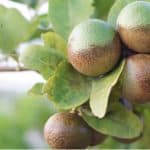Last updated on March 29th, 2022
Our site is reader supported, this means we may earn a small commission from Amazon and other affiliates when you buy through links on our site.
If you are growing lemon trees in the UK, growing them in pots is really the most successful way. There are, however, some provisions to follow when choosing and planting your lemon trees as well as some easy to follow care advice.
If your lemon tree is losing its leaves, read our guide on the possible causes and solutions.
Recommended citrus lemon varieties
Dwarf Meyer Lemon Tree
There are ample varieties of lemon trees, but not all are created equally. Some dwarf varieties will do better when grown in containers. The Dwarf Meyer Lemon tree, for example, is a great container option with its medium-sized, slightly sweet fruit and fragrant flowers. Now, the taste won’t be exactly the same as lemons from the local supermarket because this variety is a cross between an orange and lemon plant.
It is self-pollinating which means you only need one and it is the hardiest variety around. It is very resistant to insects, as well as extreme cold or heat. In terms of spacing requirements, it needs no more than a medium-size pot because it will reach just over one metre at full height in a larger pot. Being one of the fastest-growing trees you can enjoy fruit within one or two years, the lemons taking between 6 and 9 months to fully ripen.
Lisbon Lemon Tree
Another option is the Lisbon Lemon Tree, an heirloom variety much closer to what you would find on the local fruit and veg stall. The fruit has a much tangier taste but it is slightly larger than the dwarf variety, reaching just over two metres at full height although growth will be restricted in a pot.
It is disease and heat resistant but not as cold-resistant as the dwarf varieties so those residing in the Northern parts of the country would be better off with a dwarf variety while those in the Southern parts could make do with the Lisbon Lemon Tree. In either case, it is a self-pollinating tree so you need only one.
Dwarf Ponderosa Lemon Tree
The dwarf Ponderosa lemon tree is known for having the best fruit, producing overly sized grapefruit-style lemons that can weigh about 1kg. They are particularly sweet and handle the cold very well but they are not as disease-resistant or heat-resistant as the other two so they’re better off for indoor locations or patio grown lemons that get full sun exposure. They produce fruit within one or two years and are self-pollinating.
See our top recommended citrus trees for growing in pots
We recommend keeping all lemon trees indoors over the winter
We will mention that in the UK we recommend keeping all lemon trees indoors over winter and then placing them outdoors during the summer.
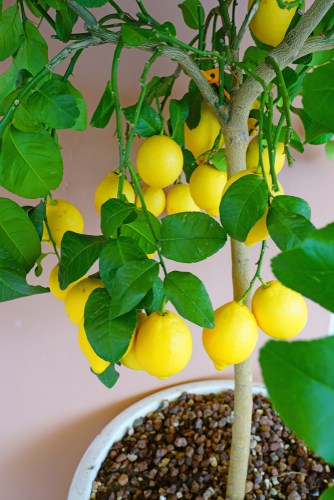
Choosing the Right Container
The right container is essential to successfully grow any of these varieties. The pot you choose must have sufficient drainage or your lemon tree will be susceptible to root rot. A rule of thumb is to get a pot that is between 25% and 50% larger than the root ball of the lemon tree.
Ceramic pots
Ceramic pots are one of the best materials because they are highly durable and finely textured which means they allow more effective drainage. The downside is of course that they are the heaviest option so it’s important that you find a final resting place for your lemon tree without any plan of moving it thereafter if you have a very big pot. This usually means growing them indoors permanently. For most this will not be a problem because it takes many years for a lemon tree to reach this size.
Terracotta and clay pots
Clay pots are a similar option, readily available in almost any garden centre you visit. The unglazed pots are slightly more durable than the ceramic ones and they dry out faster. This will help to prevent root rot.

Plastic containers
The lightest option is a plastic container. Plastic pots are suitable for use indoors or outdoors and they are the easiest to move back and forth because of how light they are. The downside is that they are less durable and they won’t drain as effectively but you can very easily drill extra holes into the bottom to help with drainage.
Wooden containers are also an option, middle of the road in terms of weight. They are less likely to crack and very slow to dry out. The most effective material against root rot is cedar or redwood. If you pick a wooden container it should be one that you use outside.
Top Tip! Be careful not to make the pot too heavy. While this won’t impact the growth of the lemons, it will certainly make it harder for you to move them at any point in the future.
It’s also worth noting that if you buy a standard lemon tree (like the one pictured below) they can become top-heavy and a heavier pot in this situation can be better.
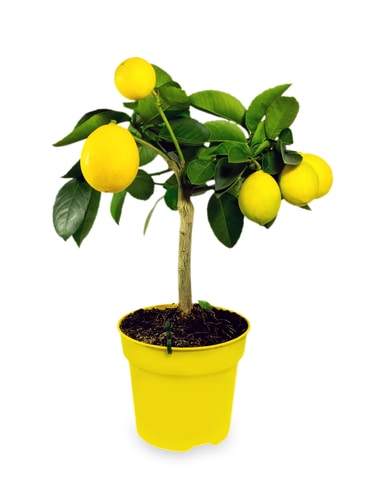
Planting a lemon tree in a pot
Compost and your own compost mix
Lemon trees can grow in just about any type of soil as long as there is good drainage. A sandy, loam-based soil is recommended but if you can’t find that, any type of potting mix that has a lot of vermiculite, perlite or horticultural grit mixed in will do just fine.
Most important is the pH level. You want to make sure the pH level remains between 5.5 and 6.5. You can get garden soil testing kits to intermittently test the pH levels and make adjustments as necessary. Our favourite compost mixture for citrus trees in general is John Innes Potting compost mixed with 25% horticultural grit. This ensures the soil retains moisture but is also free draining. You can also buy citrus compost ready mixed.
- This is a specialist blend that can be used by anybody who wants a strong and healthier plant that is provided with optimum water and nutrient availability
- The added SERAMIS granules do a fantastic job at regulating the plants water intake to ensure optimum water and nutrient availability
- This mix is loam rich to retain nutrients and for fruit development
- This 8L bag will fill a 28cm Pot
Food and Water
When growing lemon trees in a container, be sure to water the tree 2-3 times per week, or possibly more if it is outside in warm weather, remember the wind can also dry them out. You want the soil to always be moist and dark, but you don’t want to overwater. Like most plants, lemons don’t like being waterlogged because it can lead to root rot.
With regard to food, don’t fertilise a new lemon tree in a container during the first year of growth, in fact, you shouldn’t be fertilising at all. Thereafter you should only do it every other month during the spring and summer and then once per quarter in winter.
If you notice the tree looking healthy, lush, and producing fruit, don’t fertilise.
Recommended citrus feed
- Balanced nutrient solution for all citrus plants
- Ideal for all citrus trees (oranges, lemons, mandarins and tangerines) in containers, in the greenhouse or conservatory
- High levels of humic and fulvic acids designed to increase and maintain soil fertility
- Specially balanced formulation
- Simply add 10ml of Citrus Focus in every litre of clean water, weekly.
General Maintenance
Keep the soil moist
Whichever of the hybrids you choose, rest assured that lemon trees are incredibly easy to care for. Some of the most important factors are how much you water. If you keep it indoors you should water it twice per week until the soil is moist. You want the soil to remain wet but if it feels dry to the touch that’s a telltale sign that you need to increase your watering. If you’re keeping your tree outdoors you should water it every other day, more if it’s particularly warm.
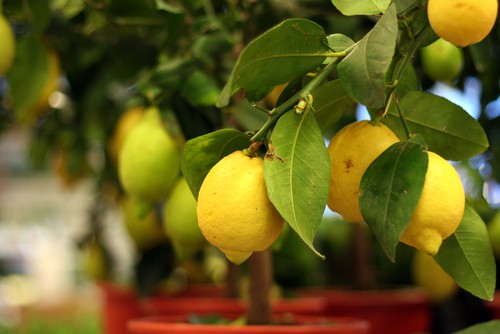
Misting
Humidity matters. Lemon trees grow best when there’s 50% humidity. Now you certainly can’t control this but you can spray with a mister now and again or place the lemon tree on a saucer filled with pebbles and keep it topped up with water.
Position in a location where it will receive 6 hours of sun a day
Equally critical is the sunlight your tree gets. Most need 6 hours of direct sunlight so if you have them outside make sure that they get exposure for at least half of the day. For this reason, placing them against your house or on a patio is an ideal location. The hotter it is, the more frequently your plant will need water but aside from this, heat is not really a problem in this position.
During the warmer months, too much sun can cause root burn. Root burn will manifest in the tree drying out or dying entirely. This is usually only a risk if your plant gets more than 12 hours of direct sunlight and it’s usually not a problem with pot-grown lemons.
Winter care
Unfortunately, frost and freezing conditions are a significant problem. To that end, as the weather turns it is certainly best to move your lemon trees inside for the winter. If you have them indoors they still need 6 hours of sunlight, so make sure that you have them near a window. If this isn’t possible and there’s no space in your home with direct access to at least six hours of sunlight, an LED grow light can help you get the job done.
Whatever you do, keep the plant away from incredibly cold weather. If the weather forecast shows that frost is pending, move the tree inside or if you must leave it outside, wrap it with horticultural fleece and wrap the pot in lagging. Similarly, you want to keep it away from strong winds. If you have an enclosed patio or another protected area that can be its permanent (or temporary) home, this will prove best. Ideally, you just want to move it indoors when the weather starts getting cooler at night.
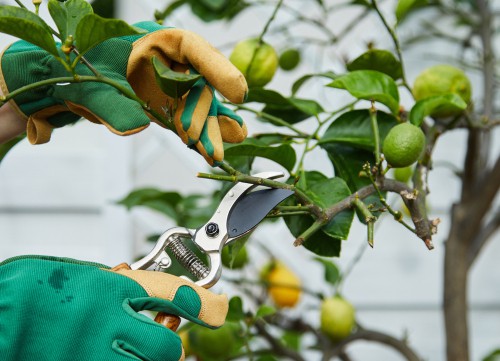
Pruning and training
Pruning is important in terms of helping the yield. You shouldn’t have to prune excessively given the limited size of container-grown lemon trees. In most cases, you would prune if the plant is starting to develop early on and it’s far too leggy, or if you see water shoots coming out of the main branch.
They should be removed immediately. If you want to encourage a bushy tree as opposed to a taller central stem you can always cut off the top of the main stem and this will force the plant to focus its energy on the lateral shoots. Incidentally, if you are training it around a trellis or up against any structure this lateral growth will prove most beneficial early on.
Realistically if you follow the recommended times for sunlight exposure and watering you shouldn’t need to prune often if at all. You will get an ample supply as long as you follow the advice for food, water and sunlight. However, it is very useful in controlling the size or promoting additional fruit growth if you absolutely need it.
Learn more about pruning citrus trees in this guide.
Pest and Diseases
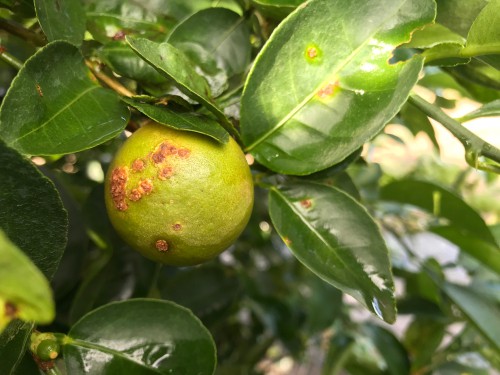
Be careful to look out for diseases and pests. When growing lemons in pots, the simplest measures you can employ to protect against this include washing all tools before you trim anything on the plant and moving the container away from any other plant that is diseased. The most common pests are spider mites, scale insects, all of which are hard to see until they have taken over, so be on the lookout throughout the growing season.
Repotting
On average you will need to re-pot the plant every three or four years. The best time to do this is in the spring. Again, the new container needs to be between 25% and 50% larger than the root ball. The night before you make the transplant, make sure you water the soil so that’s it moist. Depending on the size and the variety you might need someone to help you tip the pot downwards and pull the tree out sideways.
You can grab the tree by its trunk and rock it back and forth until it is free of the pot and then place it in the new container, backfilling the surrounding area around the root ball. Right after transplantation, you can add fertiliser and water for a full minute to help it adjust to the shock of moving. Sometimes it can be easier to break the pot with a hammer, you can always use the broken crockery as drainage in the bottom of the new pot.
Remember, care is easy if you follow these simple steps. By following all of these steps you will be well on your way to cultivating a successful lemon tree with fresh fruit readily available throughout the growing season.
Image credits – Shutterstock.com
Last update on 2025-07-18 / Affiliate links / Images from Amazon Product Advertising API



